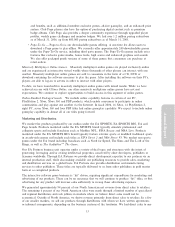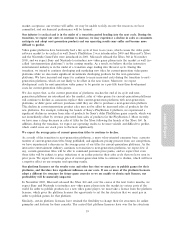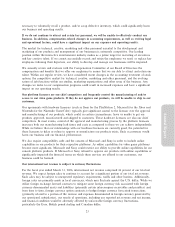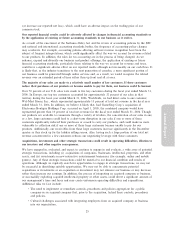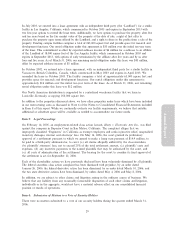Electronic Arts 2006 Annual Report Download - page 92
Download and view the complete annual report
Please find page 92 of the 2006 Electronic Arts annual report below. You can navigate through the pages in the report by either clicking on the pages listed below, or by using the keyword search tool below to find specific information within the annual report.for their future platforms and online access makes it diÇcult for us to predict our costs and proÑtability in
the medium to long term. It is also possible that platform licensors may choose not to renew our licenses.
Because publishing products for video game consoles is the largest portion of our business, any increase in
fee structures or failure to secure a license relationship would signiÑcantly harm our ability to generate
revenues and/or proÑts.
If we do not consistently meet our product development schedules, our operating results will be adversely
aÅected.
Our business is highly seasonal, with the highest levels of consumer demand and a signiÑcant percentage
of our revenue occurring in the December quarter. In addition, we seek to release many of our products in
conjunction with speciÑc events, such as the release of a related movie or the beginning of a sports season
or major sporting event. If we miss these key selling periods for any reason, including product delays or
delayed introduction of a new platform for which we have developed products, our sales will suÅer
disproportionately. Likewise, if a key event to which our product release schedule is tied were to be
delayed or cancelled, our sales would also suÅer disproportionately. Our ability to meet product
development schedules is aÅected by a number of factors, including the creative processes involved, the
coordination of large and sometimes geographically dispersed development teams required by the
increasing complexity of our products, and the need to Ñne-tune our products prior to their release. We
have experienced development delays for our products in the past, which caused us to push back release
dates. In the future, any failure to meet anticipated production or release schedules would likely result in a
delay of revenue or possibly a signiÑcant shortfall in our revenue, harm our proÑtability, and cause our
operating results to be materially diÅerent than anticipated.
Our business is subject to risks generally associated with the entertainment industry, any of which could
signiÑcantly harm our operating results.
Our business is subject to risks that are generally associated with the entertainment industry, many of
which are beyond our control. These risks could negatively impact our operating results and include: the
popularity, price and timing of our games and the platforms on which they are played; economic conditions
that adversely aÅect discretionary consumer spending; changes in consumer demographics; the availability
and popularity of other forms of entertainment; and critical reviews and public tastes and preferences,
which may change rapidly and cannot necessarily be predicted.
Technology changes rapidly in our business and if we fail to anticipate or successfully implement new
technologies or the manner in which people play our games, the quality, timeliness and competitiveness
of our products and services will suÅer.
Rapid technology changes in our industry require us to anticipate, sometimes years in advance, which
technologies we must implement and take advantage of in order to make our products and services
competitive in the market. Therefore, we usually start our product development with a range of technical
development goals that we hope to be able to achieve. We may not be able to achieve these goals, or our
competition may be able to achieve them more quickly and eÅectively than we can. In either case, our
products and services may be technologically inferior to our competitors', less appealing to consumers, or
both. If we cannot achieve our technology goals within the original development schedule of our products
and services, then we may delay their release until these technology goals can be achieved, which may
delay or reduce revenue and increase our development expenses. Alternatively, we may increase the
resources employed in research and development in an attempt to accelerate our development of new
technologies, either to preserve our product or service launch schedule or to keep up with our competition,
which would increase our development expenses.
Our business is intensely competitive and ""hit'' driven. If we do not continue to deliver ""hit'' products
and services or if consumers prefer our competitors' products or services over our own, our operating
results could suÅer.
Competition in our industry is intense and we expect new competitors to continue to emerge in the United
States and abroad. While many new products and services are regularly introduced, only a relatively small
20





